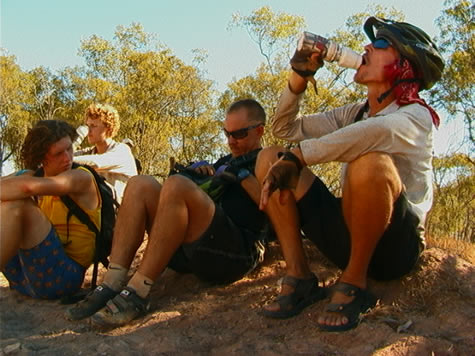2001 August 6, Monday. Pinnacle Springs Station.
It’s difficult to convey the extreme intensity of the tropical Australian sun to anyone who has not experienced it. When you’re out here on a bicycle, with only what you can carry on your back, your complete reliance on water makes you feel very small. The thought of our supplies expiring could turn us into savages in no time flat, as we have already had glimpses of within the team.

Damage to the ozone layer, the protective barrier shielding our earth from harsh ultra-violet light, is the fundamental cause of the severity of the sun today, and has developed largely through human insensitivity, and abuse of resources.
Ultra-violet light, unfiltered by sufficient ozone, is not only uncomfortable, but also dangerous. It can be divided into three types of rays:
UV A: which is responsible for aging of both skin and eyes;
UV B: which causes burning; and
UV C: which is carcinogenic, or cancer causing.
While people are now mostly well informed about the danger of exposing unprotected skin to midday light, the beach bathers of yesterday are paying the price for their fun in the sun. Damaged eyes and skin cancers are the most common results of a life spent enjoying the warmth of the summer sun in Australia.
One Australian icon which has helped to protect outdoor workers and players from this natural hazard is the Akubra hat. As we cycled into Pinnacle Springs Cattle Station yesterday, and were greeted by Laura and Emma Kruckow, one of the first things we noticed was their headwear. Both sisters wore broad brimmed white Akubra hats which seemed almost bigger than the girls themselves.
Most country Australians own at least one Akubra, and they come in as many shapes, sizes, and colors as the characters who wear them. At rural shows and stock sales, the broad range of hats on display is an exhibition in itself. Travelers collect pins from all over the country and sport them around the crowns of their hats. Some people wear one hat for twenty or thirty years, dragging it through dust and grease, sitting on it, and wearing holes in it, until it develops a character inseparable from its wearer.
Suggested learning activity: do you need to guard yourself from the sun where you live? How do you protect yourself when outdoors or in the water? Do you or someone in your family have a special hat? How can we help to save our ozone layer from damage by chloroflurocarbons?
bel